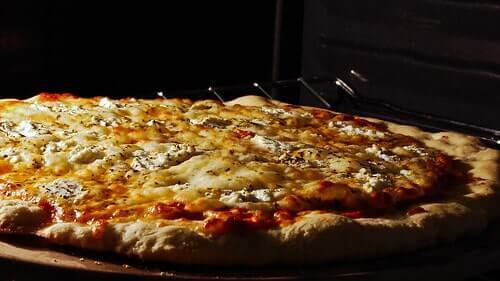
Ever wondered how pizzerias get their pizza to taste so good? One of the keys to amazing pizza is a super-hot oven, which the average person may not have at home. Another key is the right cooking surface. For perfectly cooked pizza every time, always place your pie atop a pizza stone for baking. If you haven’t used a pizza stone before, check out our tips for making a delicious pizza with one for your oven, along with care instructions and making the most of this kitchen essential.
What Is a Pizza Stone?

Image via Flickr by RLHyde licensed CC BY-SA 2.0
A pizza stone is a flat slab of ceramic or stone that you place directly on the rack of your oven. It’s one of a category of kitchen tools known as baking stones, which are designed to transfer heat to the bottom of what’s being cooked on them for slower, more even baking. Pizza stones come in a wide range of sizes and thicknesses. A thicker pizza stone generally works better than a thinner one, but the larger, thicker stones are also more expensive. The cost of your stone also depends on the material from which it’s made.
When you place a pizza stone on your oven rack, it absorbs the heat produced within the oven and transmits that heat to the raw pizza dough placed on top of it. Some people believe that pizza stones absorb excess moisture during the cooking process, but as the dough warms up, the natural process of evaporation actually causes the moisture to disappear.
The porous nature of a pizza stone does serve a purpose, which is to aid in the evaporation process or allow moisture to escape faster. A metal pizza pan may trap the steam as it tries to escape the dough, potentially resulting in a soggy crust. However, the heat transmitted from the stone to the dough is really what makes a pizza stone work so well.
Making Your Perfect Pizza
When you want to whip up an amazing pizza pie, the first step is prepping your pizza stone. Preheat your oven to 500 degrees, and place the pizza stone inside as soon as you turn on the oven. As the oven heats up, the stone will also heat and become ready for baking. Next, grab your favorite dough and roll it out to be just smaller than the size of your stone. Place sauce and toppings on top of the dough, then carefully slide the uncooked pizza onto the stone. For safety, you may want to invest in a wooden pizza paddle, which is the perfect tool for sliding pizza on and off the stone.
The baking time for your pizza depends on the thickness of the crust, but keep an eye on it within the oven and pull it out when the crust starts to turn golden brown and the cheese is melted and lightly browned. You can use your handy paddle to remove the pizza from the oven and to avoid burns. Turn off the oven and allow the stone to cool down before removing it from the rack.
How To Care For a Pizza Stone
The manufacturer of each stone will have its own care recommendations, although you should generally keep the stone dry and store it in a place where it’s not susceptible to sharp changes in temperature. The material of a stone can experience thermal shock, which occurs when the stone goes from one temperature to another quickly. This temperature change can often cause the stone to crack. The risk of thermal shock is the reason it’s important to place your stone in a cold oven, rather than placing a cold stone in an already preheated oven.
Avoid seasoning your pizza stone, unless the manufacturer says otherwise. The material can absorb oil and other seasonings, resulting in smoking or unpleasant odors every time you bake a pie.
Many pizza stone owners keep them in the oven all the time, even when they’re not in use. Doing so can ensure that it never experiences rapid temperature changes. Another benefit of keeping your stone in the oven is the equalization of the heat of the oven, reducing hot spots that cause your food to cook too fast. If you do decide to store your pizza stone in the oven all the time, be aware that it will add some time to how long it takes to preheat the oven.
You should avoid submerging your pizza stone in water. The porous material can absorb the soap used to clean it, which means your next pie might have a soapy flavor. Instead, brush the crumbs off the stone after each use. If you have burned-on or crusty spots after baking a pizza, you can use food-safe cleaning materials, such as a teaspoon of baking soda dissolved in some warm water. Wipe up any debris with a dry or damp cloth, and dry the stone for at least a few hours before you use it again.
Tips To Make the Most of a Pizza Stone
Using a pizza stone is great for making delicious pizza, but that’s not its only use. You can try making other tasty options on your stone to make the most of this kitchen must-have. Next time you roast fresh veggies in the oven, place them atop your stone instead of on a baking sheet. You can still coat them with oil and your favorite seasonings to get a good flavor. Make sure to stir them occasionally as they roast.
Ever enjoyed a giant cookie? You can make your own drool-worthy treat on a stone by scooping raw cookie dough onto the greased stone. Press it down to make it even and level, and bake at the temperature indicated in the recipe. You may need to keep the big cookie in the oven for a few extra minutes.
A pizza stone is also great for heating frozen foods, as it helps absorb any ice crystals that may have accumulated within the freezer. If you’re cooking frozen foods, this is the one time you shouldn’t preheat the stone, because placing cold food on a hot stone can damage your favorite eats.
Take advantage of the benefits of cooking on a pizza stone and whip up a delicious pie for dinner tonight. Not in the mood to cook? Keep your stone in the oven and order your favorite from Pequod’s Pizza.